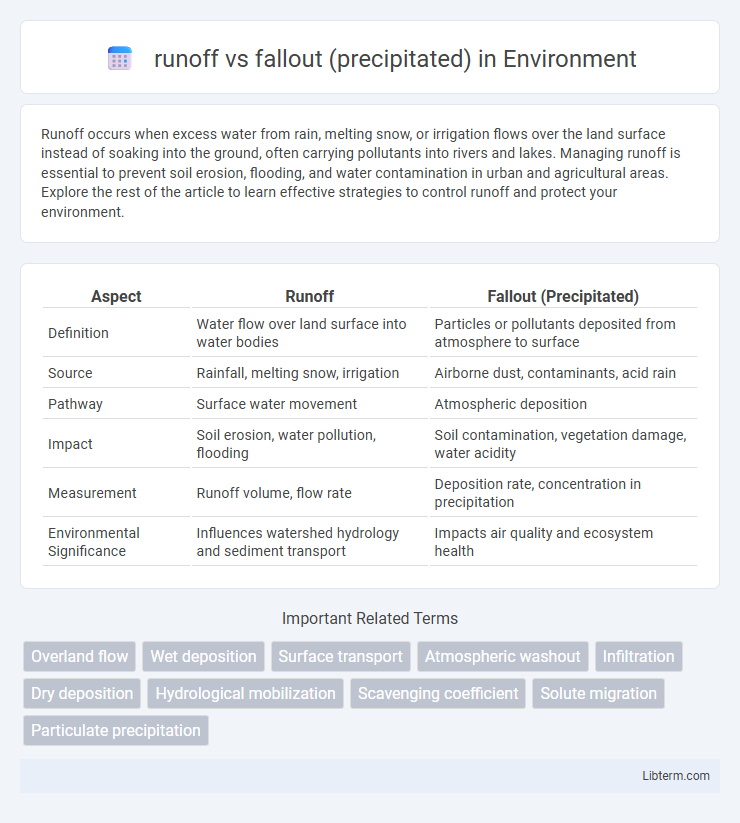Runoff occurs when excess water from rain, melting snow, or irrigation flows over the land surface instead of soaking into the ground, often carrying pollutants into rivers and lakes. Managing runoff is essential to prevent soil erosion, flooding, and water contamination in urban and agricultural areas. Explore the rest of the article to learn effective strategies to control runoff and protect your environment.
Table of Comparison
| Aspect | Runoff | Fallout (Precipitated) |
|---|---|---|
| Definition | Water flow over land surface into water bodies | Particles or pollutants deposited from atmosphere to surface |
| Source | Rainfall, melting snow, irrigation | Airborne dust, contaminants, acid rain |
| Pathway | Surface water movement | Atmospheric deposition |
| Impact | Soil erosion, water pollution, flooding | Soil contamination, vegetation damage, water acidity |
| Measurement | Runoff volume, flow rate | Deposition rate, concentration in precipitation |
| Environmental Significance | Influences watershed hydrology and sediment transport | Impacts air quality and ecosystem health |
Understanding Runoff: Definition and Processes
Runoff is the flow of water, usually from precipitation, that travels over the land surface and eventually reaches streams, rivers, or other bodies of water, influenced by factors such as soil saturation, land slope, and vegetation cover. Fallout refers to materials, such as pollutants or particles, that precipitate from the atmosphere and settle onto surfaces, potentially contributing to contamination in runoff. Understanding runoff involves analyzing how precipitation is absorbed, infiltrates, or moves across the terrain, impacting water quality and quantity in hydrological systems.
What is Fallout (Precipitated): Key Concepts
Fallout (precipitated) refers to the process where airborne particles or pollutants settle out of the atmosphere and deposit onto surfaces due to gravity, often after chemical reactions in the atmosphere cause them to become heavy enough to fall. This natural cleansing mechanism removes contaminants like dust, pollen, or industrial emissions, influencing air quality and soil composition. The rate of fallout depends on particle size, atmospheric conditions, and precipitation patterns, distinguishing it from runoff, which involves liquid water transporting substances over land surfaces.
Sources and Causes of Runoff
Runoff primarily originates from precipitation that exceeds the infiltration capacity of the soil, often exacerbated by urbanization and deforestation, which reduce natural absorption and increase surface flow. Sources include rainfall, snowmelt, and irrigation, with impervious surfaces like roads and rooftops significantly accelerating runoff volume and velocity. Soil compaction, vegetation removal, and steep slopes further enhance runoff by limiting water infiltration, leading to increased surface water flow and potential flooding.
Formation and Mechanisms of Fallout (Precipitated)
Fallout, or precipitated particulate matter, forms when airborne particles aggregate and grow heavy enough to settle due to gravity, often through mechanisms such as coagulation, nucleation, and condensation. This process differs from runoff, which involves the flow of liquid water over land surfaces, carrying dissolved or suspended materials to water bodies. Fallout formation is influenced by atmospheric conditions, particle size distribution, and chemical composition, leading to deposition on terrestrial and aquatic environments.
Differences Between Runoff and Fallout
Runoff refers to the flow of water, usually from precipitation, that travels over the land surface and drains into rivers, lakes, or oceans, while fallout pertains to particles or pollutants that settle from the atmosphere to the Earth's surface. Runoff primarily involves liquid water movement influenced by terrain, soil saturation, and precipitation intensity, whereas fallout consists of solid or particulate matter deposition driven by atmospheric conditions and gravity. The key distinction is that runoff is a hydrological process involving water flow, whereas fallout is an atmospheric deposition process involving particles settling out of the air.
Environmental Impacts of Runoff
Runoff significantly contributes to environmental degradation by transporting pollutants, such as fertilizers, pesticides, and heavy metals, into water bodies, leading to eutrophication and habitat destruction. Unlike fallout, which deposits airborne particles gradually and can be filtered by vegetation, runoff causes rapid and concentrated pollution events that overwhelm aquatic ecosystems. Managing runoff through green infrastructure and permeable surfaces is critical to reducing sedimentation, nutrient loading, and chemical contamination in rivers and lakes.
Environmental Impacts of Fallout (Precipitated)
Fallout (precipitated) consists of atmospheric particles that settle onto surfaces, often containing harmful pollutants like heavy metals and radioactive isotopes, which can contaminate soil and water bodies. This precipitation of airborne contaminants disrupts ecosystems by introducing toxins that affect plant and aquatic life, leading to bioaccumulation and ecosystem imbalances. Unlike runoff, which transports surface pollutants primarily from land to water systems, fallout directly deposits contaminants, increasing the risk of long-term environmental degradation and posing significant challenges for pollution control and remediation.
Runoff vs Fallout: Effects on Water Quality
Runoff carries pollutants such as fertilizers, pesticides, and sediments from urban and agricultural areas directly into waterways, significantly degrading water quality by increasing nutrient loads and turbidity. Fallout, consisting of atmospheric deposition of contaminants like heavy metals and particulate matter, influences water bodies more gradually but can accumulate toxic substances over time. Understanding the contrasting impacts of runoff and fallout on water quality is essential for developing targeted pollution control strategies in watershed management.
Management and Mitigation Strategies
Runoff management strategies emphasize infiltration techniques such as green infrastructure, permeable pavements, and rain gardens to reduce surface water flow and prevent pollutant transport. Fallout precipitation, primarily involving airborne particulates settling, is mitigated through air quality controls like emission reductions, vegetation buffers, and dust suppression measures. Combining source control with landscape design enhances overall mitigation effectiveness for both runoff and fallout contamination.
Conclusion: Choosing Between Runoff and Fallout Solutions
Selecting between runoff and fallout solutions depends on site-specific environmental goals and contamination types. Runoff solutions effectively manage surface water and minimize pollutant transport over large areas, while fallout solutions target airborne particulates that settle quickly and localize contamination. Prioritizing factors such as pollutant characteristics, site hydrology, and desired cleanup outcomes ensures optimal remediation strategy selection.
runoff Infographic

 libterm.com
libterm.com